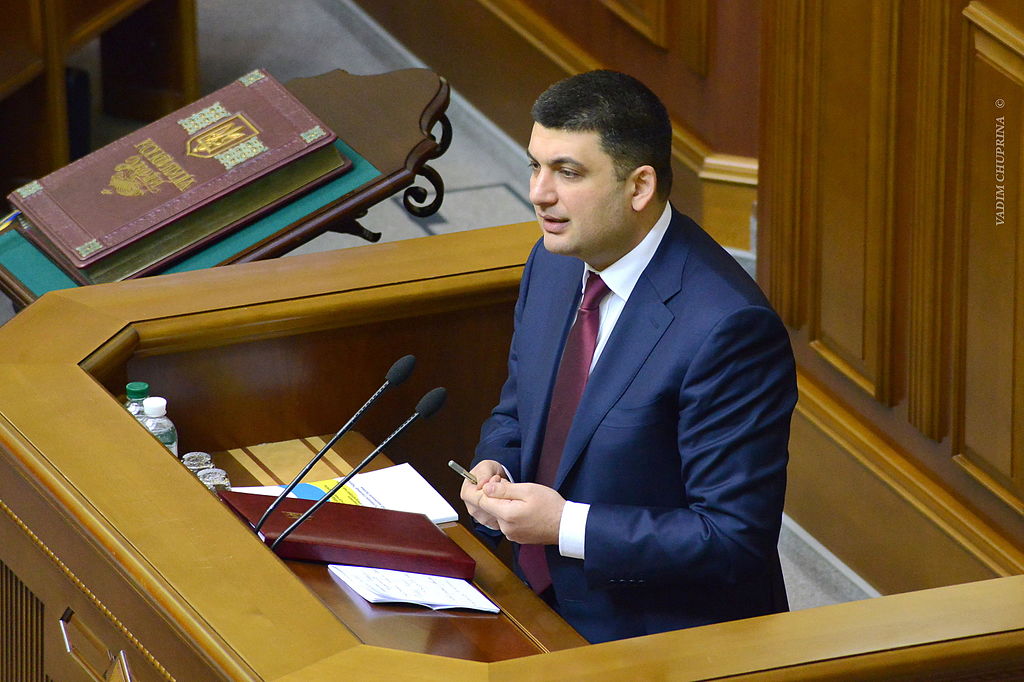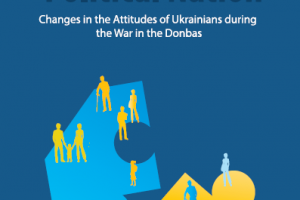Ukraine’s most underreported reform
Written by Yuriy Hanushchak, Oleksii Sydorchuk and Andreas Umland
 Ukraine’s decentralisation was one of the first, fastest and most comprehensive reforms initiated by the initial post-EuroMaidan government in March 2014, and its then vice-prime minister and today head of government Volodymyr Groysman. While amounting to a deep transformation of state-society relations in Ukraine, the underlying ideas and first successes of this large restructuring of Ukraine’s governmental system have so far been hardly noted outside Ukraine. Contrary to widespread Western belief, neither the concept nor the initiation of decentralisation had much to do, as some believe, with Ukraine’s Association Agreement with the EU signed in July 2014, or with the Minsk Agreements signed in September 2014 and February 2015. Now entering its third year, the ongoing reorganisation of Ukraine’s local public administration, instead, had already been hotly discussed, meticulously planned and unsuccessfully attempted for many years before the 2013-2014 Revolution of Dignity.
Ukraine’s decentralisation was one of the first, fastest and most comprehensive reforms initiated by the initial post-EuroMaidan government in March 2014, and its then vice-prime minister and today head of government Volodymyr Groysman. While amounting to a deep transformation of state-society relations in Ukraine, the underlying ideas and first successes of this large restructuring of Ukraine’s governmental system have so far been hardly noted outside Ukraine. Contrary to widespread Western belief, neither the concept nor the initiation of decentralisation had much to do, as some believe, with Ukraine’s Association Agreement with the EU signed in July 2014, or with the Minsk Agreements signed in September 2014 and February 2015. Now entering its third year, the ongoing reorganisation of Ukraine’s local public administration, instead, had already been hotly discussed, meticulously planned and unsuccessfully attempted for many years before the 2013-2014 Revolution of Dignity.
Thus, in 2005, following the Orange Revolution, a law on a new administrative and territorial set-up of Ukraine had been drafted. In 2009, Ukraine’s government approved the Concept for Local Self-Government Reform. Yet, when Viktor Yanukovych took over as president a year later, the imminent re-organisation of Ukraine’s regional governmental system came to a halt. These and other earlier developments, nevertheless, prepared Ukrainian society and politics to move ahead quickly once Yanukovych was out. Only little more than one month after the victory of the Revolution of Dignity on February 21st 2014, the new government of Arseniy Yatsenyuk adopted a modified Concept for the Reform of Local Self-Government and Territorial Set-Up of Power that kick-started the decentralisation reform.
The many years of discussion and eventual start of implementation of decentralisation reforms in April 2014 were primarily motivated by the excessive concentration of powers and resources in the centre. When Ukraine became independent in 1991, it inherited from the Tsarist as well as Soviet systems of rule an allocation of almost all prerogatives in the capital. Until today, features of the previous over-centralised and semi-colonial governmental system can be found in many officially state-socialist and post-socialist countries across the globe. Arguably, decentralisation is therefore no less important for post-Soviet countries to overcome their Tsarist, Leninist and Stalinist legacies than liberalisation, decolonisation, democratisation, privatisation and Europeanisation (i.e. the adoption of the EU’s acquis communitaire).
The overconcentration of competencies in the capital does not only lead to a number of political, administrative, economic, legal, cultural, behavioural and even mental pathologies in the post-Soviet world. It is, above all, the main reason for the low quality of public services throughout Ukraine, including such fields as primary as well as secondary education, healthcare, road construction or social support. It is also one of the causes for the slow economic development of many Ukrainian regions, during the last 25 years. Ukraine’s local authorities often lacked and are partly still lacking sufficient funds, powers and skills to address even the most basic infrastructural needs of their communities. Ordinary citizens had and often still have little opportunity to influence decisions affecting their most urgent immediately local matters. Since 2014, the government has thus adopted a whole battery of parallel measures to change previous centre-periphery relations. These multiple re-directions and novel regulations, taken together, amount to a comprehensive decentralisation reform.
First, local authorities are now receiving far larger revenues through redistribution of tax income from the central state budget to municipal and communal accounts. For instance, during 2015, the monetary volume of local budgets increased by 42 per cent compared to 2014 – from 70.2 billion hryvnas (around 2.5 billion euros) to 99.8 billion hryvnas (around 3.5 billion euros). In 2016, the local communities’ revenues increased additionally by 49 per cent reaching 146.6 billion hryvnas (five billion euros). In fact, they earned 16 per cent more than had been initially projected for that year. This unexpected rise of local revenues, especially via personal income tax (PIT), was the result not only of inflation, but also of new taxation formulae that motivated businesses to pay their taxes properly and to get away from handing out salaries in envelopes. In addition, a new model of competitive distribution of inter-budget transfers is aimed at fostering both the support of weaker regions and economic rivalry among local communities.
Second, in order to increase the institutional and financial capacity of local authorities, the government initiated a process of voluntary unification of small counties into administratively more potent and larger political subunits called “amalgamated territorial communities” (ATCs). That was a highly necessary step to get away from the large number of over 11,000 Ukrainian primary level counties. For instance, before the reform, 6,000 local communities had fewer than 3,000 residents. Within 5,419 budgets of local self-government, subsidies from the centre exceeded 70 per cent. 483 territorial communities were at 90 per cent or more maintained via support from central state budget funds.
No wonder that this part of the decentralisation reform, once unification became possible, quickly got off the ground. Already by the end of 2016, the so far entirely voluntary amalgamation process had rendered impressive results: 15 per cent of the previously existing local counties had – on their own initiative and without any pressure, though with some financial incentive, from above – fused into 367 amalgamated territorial communities (ATCs). Apart from new competencies, the new ATCs received additional tax revenues and direct state subsidies for developing infrastructure, improving healthcare, and implementing educational projects. Due to their new revenues, those 159 amalgamated communities that had been created during 2015 increased, as Ukraine’s Ministry for Regional Development proudly reported, their budgets more than six-fold, during the first nine months of 2016 when compared to the analogical period of 2015. The new entities received various types of revenues, especially PIT, and additional competencies to direct their expenditures.
Some rapid physical developments in the first amalgamated territorial communities represent the, so far, most visible results of the decentralisation. The officials of the new ATCs used much of the additional resources they now had at their disposal for infrastructural projects in order show their communities’ inhabitants quickly the benefits of their novel political functions and administrative prerogatives. For instance, in 2016, more than twice more road surface was laid, in Ukraine, than during the two previous years (though this was also a result of the general economic recovery that had begun in mid-2016). The central government provides financial assistance to amalgamated communities in the form of state subsidies which amounted to approx. one billion hryvnas (35 million euros) in 2016 and will be around 1.5 billion hryvnas in 2017. The ATCs have been using the additional funds for the reconstruction and repair of educational and healthcare facilities as well as for other public works.
Another aim of decentralizing and bundling decision-making has been to enable ATCs to attract larger investment projects. So far, these have, however, been rare, and reflect the generally low amounts of FDI that Ukraine is receiving. That has, perhaps, less to do with Ukraine governmental structure than with the country’s poisoned international image as an allegedly war-torn and still super-corrupt country – features that are certainly present, yet often overdrawn in international press reports.
A recent amendment to the law on the amalgamation of communities allows now so far non-amalgamated counties to join already amalgamated communes via a simplified annexation procedure. It is, therefore, expected that by the middle of 2017, the number of ATCs will grow to more than 60 per cent of their envisaged final number for the whole of Ukraine. If that indeed happens, it will signal that this critical component of the decentralisation reform will become irreversible. Over the next two years, the government also expects to enlarge the sub-regional territorial units, the so-called rayons (districts), that Ukraine inherited from the Soviet administrative system. Together with further progress in the amalgamation of communities, the reorganisation of the rayons would largely finalise the territorial reform as a key component of the decentralisation drive, until the end of 2018.
Other aspects of the reform package, however, remain frustratingly incomplete, as the parliament has so far failed to adopt a critical constitutional amendment. The modification of Ukraine’s basic law is necessary to complement and support the already enacted changes in ordinary legislation and ongoing changes in the local communities’ everyday life. While originally not connected to the resolution of the armed conflict in the Donets Basin (Donbas), the constitutional changes related to decentralisation were, in 2015, bundled together with one of Ukraine’s political commitments, under the Minsk process. The latter concerns the provision of a highly controversial “special status” for the Donbas territories currently controlled by Russia and its proxies, in eastern Ukraine. Against the background of Moscow’s demonstrative and continuous violation of the Minsk Agreements since 2014, a large majority of MPs in Ukraine’s parliament, the Verkhovna Rada, so far refuses to support the comprehensive constitutional reform package. That is insofar regrettable as this legal bundle also includes several decentralisation clauses, unrelated to the Minsk process.
In fact, a final vote on these constitutional changes may, in view of Ukraine’s growing frustration about Russia’s continuously aggressive behaviour during the last three years, never happen. Allowing for an unclear “specificity in the conduct of local government in several regions of Lugansk and Donetsk region,” as prescribed in the draft amendments, is by many politicians considered as illogical, unjust and subversive. It creates the possibility for a transfer of more power to separatist-held Donbas areas than to the communities in the Ukraine-controlled part of the region. The Minsk Agreements’ provisions to allow the currently occupied territories to appoint their own armed local militias, city procurators and other such organs not subordinated to central government were forced upon Ukraine, in February 2015, at gun-point. These special regulations are now being more and more outspokenly rejected by many of Ukrainian society’s crucial stakeholders, including political parties, leading intellectuals, and economic actors.
The constitutional bill also ran into opposition from some parliamentarians because of a clause that introduces, into Ukraine’s administrative system, a new organ – the so-called prefects. These are president-appointed regional public officials who will be monitoring the legality of the local authorities’ decisions and who can suspend them and refer them to the courts. The authors of the draft amendment argue that appointment of such prefects is necessary for preserving state control over newly empowered local governments, which could abuse their novel competences. Critics, on the other hand, fear that through the prefects, the president may unduly enhance his political influence over local authorities and undermine genuine communal self-government. Such worries – so far rather hypothetical – could be taken care of in the future should lawmakers were to design a transparent system of selection of prefects by open competition allowing them to be independent from the president. As the exact competences of the president, government, prefects and parliament are, in the draft for the amended constitution, more clearly delineated than in the current basic law, abuses of power would probably altogether decline rather than increase.
Despite the only partial and, so far, largely voluntary implementation of the reform package, many Ukrainians have already started to note implications of decentralisation. According to a November 2016 poll by the Kyiv International Institute of Sociology, for instance, 46 per cent Ukrainians saw positive changes from the use of new funds obtained by local authorities, while 43 per cent saw no change, and five per cent saw changes for the worse. Twenty-five per cent pointed to improvement of public services in their communities compared to 58 per cent who didn’t notice any changes and eight per cent who felt there had been deterioration of public services. While a clear majority of Ukrainians of 64 per cent support decentralisation and empowerment of local authorities, 61 per cent are still not satisfied with the slow pace of the reform.
In early 2017, Ukraine’s decentralisation reform has entered a critical phase marked by a recent adoption of several new laws aimed at fostering amalgamation of communities. This encouraging legislative success offers hope that the already impressive practical progress will continue. To date, decentralisation has already improved the financial well-being of many local communities in different regions in Ukraine and laid the foundation for a better quality of life for Ukrainians living outside the richer metropoles like Kyiv, Odesa and Kharkiv. While the idea of rapid decentralisation does not enjoy unconditional support from all parliamentary parties, the numerous stakeholders of the ongoing reform among public officials, elected mayors and new councillors, as well as the population at large, bode relatively well for the future of local administration reform. In addition, various Western states and international organisations, above all the EU, are resolutely supporting Ukraine’s decentralisation via a broad variety of instruments and with funding amounting altogether to approximately EUR200 million. If the accelerating changes take root at the local level, decentralisation will contribute to changing post-Soviet Ukrainian state-society relations, at its core.
Yuriy Hanushchak is Director of the Institute for Territorial Development at Kyiv, and an expert for Ukraine’s NGO umbrella association “Reanimation Package of Reforms.”
Oleksii Sydorchuk is a political analyst at the Ilko Kucheriv Democratic Initiatives Foundation, a Ukrainian non-governmental think-tank, at Kyiv.
Andreas Umland is a research fellow at the Institute for Euro-Atlantic Cooperation in Kyiv, and editor of the book series “Soviet and Post-Soviet Politics and Society”.
The authors are grateful to Dominik Papenheim (U-LEAD project), from the EU Delegation at Kyiv, for some useful advice on an earlier draft of this article.









